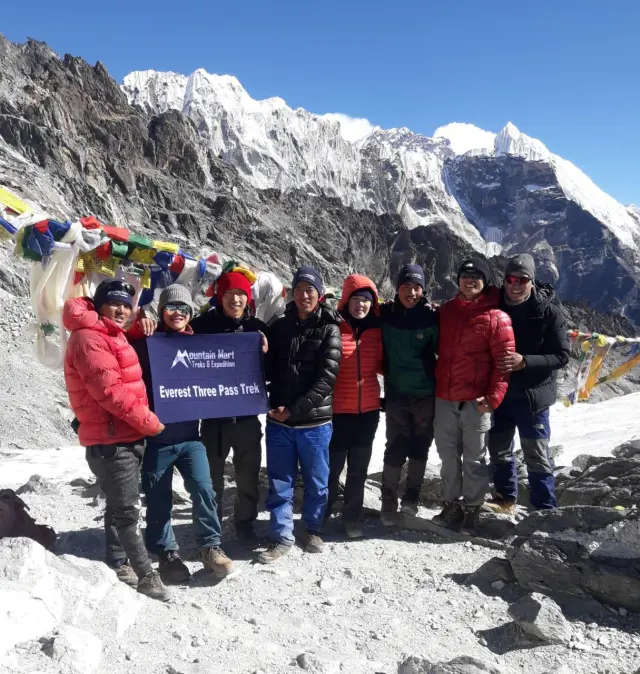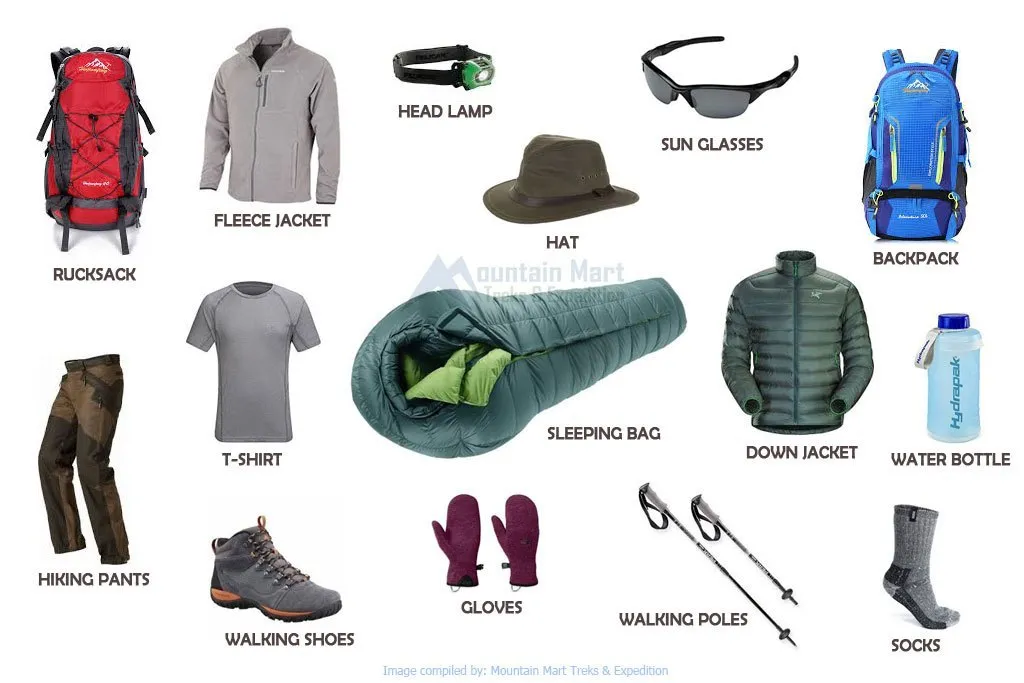Everest Base Camp Packing List - What you need for EBC Trek?
Trekking in the mystical Himalayas is once in a lifetime experience. But, the trek can be a worse nightmare if you fail to arrange a complete Everest Base Camp packing list for Everest Base Camp Trek. Many Trekkers seem to be confused and have less knowledge about the Everest Base Camp packing list; it has become a tough task for them. What to pack and how to pack the necessary items is really very important. So, we have prepared the best guideline that will help you to choose the best Everest Base Camp packing list for the Everest Base Camp Trek. Packing the right gears and appropriate clothes play a vital role to accomplish the trek in a safer and comfortable manner. You must include the trekking gears, clothes, footwear, tools, and gadgets in the packing list while trekking in the higher elevation of the Everest region. These gears and tools can be easily found in Kathmandu and Namche Bazaar. You can hire or purchase the trekking gears appropriate for the trekking season and as per your convenience. But, make sure that the gears and clothes you purchase are of good quality, genuine, and affordable.
What do you need to include in the Everest Base Camp Packing List?
Clothing:
There are different items you need to include in your Everest Base Camp packing list for Everest Base Camp Trek. Clothes really matter the most for the comfortable and successful trekking. The list of the clothes could be different according to the different trekking seasons. Check the weather so you will be able to add appropriate and useful trekking clothes. Trekking clothes and jackets: Dress in a layer so that you can add or remove the clothes according to the temperature of that time. Shirts and Jackets: You need to pack the base layer, trekking shirts, insulated jacket (fleece jacket), and waterproof outer layer jacket (down jacket) to keep yourself warm. Choose the moisture-wicking materials rather than cotton clothes. Trekking trousers: Add the comfortable, waterproof, and fleeced trousers in the packing list for Everest Base Camp Trek. Carry at least 2 trekking trousers and comfortable shorts. Underwear: It is better to have a couple of sports underwear in the list. Breathable and moisture-wicking underwear are the most appropriate ones for trekking. Headwear: To protect yourself from heat and cold while trekking in the Everest Region, you need proper headwear like: Wide brim trekking hat: To protect your face in the bright sunny daylight, you must have a trekking hat. Woolen cap or Beanie: In the higher region, the cold air can make us sick. So, wear woolen Beanie. Neck Gaiter or neck warmer: To protect yourself from the cold breeze and dusty air in the arid Himalayas, always have a scarf as face cover. It protects your nose and neck. Gloves: Hands are the most exposed parts of the body. So, while trekking in the higher region, add waterproof and fleece gloves in the Everest Base Camp packing list for Everest Base Camp Trek to be safe from frostbite. Inner gloves: The gloves are useful for the day broad light. If the temperature is extremely cold, you can use it as an inner protector. Waterproof Insulated gloves: If the climate is too cold or if it is raining, waterproof gloves are the most needed wear to protect the hands. Footwear: Blisters, aches, and Raynaud syndrome are some of the serious problems you will face while trekking if you don’t have proper boots and socks. So, comfortable and sturdy walking shoe is the most important gear one should possess. Hiking boots: You must include a comfortable, right-sized, reliable, and waterproof hiking boot if you don’t want to regret in Everest trek. Light and cozy trekking shoes: Walking in hiking boots all the time could numb the toes. You can use light-weight shoes during the day tour in Kathmandu or in Namche while strolling around the cafes, bars, restaurants, etc. Sandals: While staying at the lodges during rest day or in the evening time, the sandals are the appropriate footwear to have. Hiking socks: Add 5-6 moisture wicking woolen hiking socks in the packing list for a cozy walk. Thermal socks: If you are trekking in the winter season, you need to add warm thermal socks in the list. Shoe gaiters: Gaiters are the special garments strap over the shoes and around the legs to protect from water, mud, thrones, snow, and bugs.
Bags, backpacks, and rain cover:
.webp)
The gears, clothes, and other tools are laden in the bags. So, bags really matter while trekking in the Everest Region. Use light, comfortable, and waterproof bags for the easy and pleasurable trek. Always use the comfortable so that the Everest Base Camp Packing list can be easily included. Be aware, heavy backpacks can tire the porters as well as the trekkers too. Duffle bags: The duffle bag is carried away by the trekkers and it is perfect to include the gears. MMT provides each duffle bag to the individual trekker; therefore, you don’t need to purchase the duffle bags. Backpack: Carry an easy backpack if you are trekking individually. Around 50-60 Liter bag with an opening at the top will be the best choice for trekking. Daypack: Some personal documents, rain gears, medicines, and other necessary items should be carried by the trekkers in the daypack during the trek.
Sleeping Gears:
Sleeping bag: Tea houses in the EBC trekking routes provide the facilities of quilt/duvet to the trekkers. But, there is no guarantee of warmth and clean quilt. So, it is always a better idea to carry a sleeping bag with you. If you are planning to go to Peak climbing then you definitely need a sleeping bag. Sleeping liner: Along with the sleeping bag, you need an extra liner to take cozy rest. Eye mask and earplugs: To avoid any unpleasant noise, gossip, and snoring while taking rest at tea houses, eye masks and earplugs can become a better tool for you.
Trekking gears:
Trekking poles: While trekking in the higher elevation, trekkers are suggested to use the trekking poles as support. It basically reduces the joints pain and helps to walk steadily. MMT offers the trekking poles to all the trekkers. Sunglasses: Always carry UV protection and light reduction sunglasses. The two in one glasses help to walk in sunny light or in the evening time. Headlamp: Sometime there will be low lights due to fog and mist so you need a torch or headlight while trekking.
Accessories and gadgets:
Water bottle/ hydration bladder: Dehydration results in acute mountain sickness; therefore, trekkers must hydrate while trekking in the higher altitude. You can’t find the tea houses everywhere on the trails so a water bag is recommended for the trekkers to include in the Everest Base Camp packing list. Pee funnel: It is not possible to find toilet all along the trekking routes. Also, some tea houses don’t have enough toilets for many trekkers during the best trekking seasons. So, it is better to carry a pee funnel for the convenience. Camera: If you are a professional photographer, carry a DSLR camera along with few camera lenses. Otherwise, a simple camera or smartphone can also be used for taking photos. Camera battery/ Portable charger: You need extra camera battery as batteries drain quickly in the cold temperature. Most of the tea houses have charging facilities, but they make you pay for it. So, it is wise to bring own portable charger. Power bank: The battery of your cell phone quickly drains and needed to be charged frequently in the cold temperature. It is better to carry a power bank while trekking in the Everest Region.
Documents and Money:
Insurance: You must get a travel or trekking insurance from a registered insurance company if you are trekking in the Himalayas. The travel insurance must include:
- Baggage insurance: When your luggage or bag gets lost during the traveling hour, you will get all the claimed goods back if you have done baggage insurance.
- Flight insurance: It helps the trekkers to get money refund if the flights get canceled.
- Medical evacuation: It is the most important one as if you get suffered from Acute Mountain Sickness (AMS) in the higher elevation. The medical evacuation covers the helicopter evacuation in case of emergencies.
Passport/visa: If you are traveling to the different parts of the world then you definitely need legal Passport and visa. Always keep it safe and within yourself your reach while trekking. Visa cards/ATM card/ Cash: Bring some cash money or ATM card with you as you need it during your stay in Kathmandu. The money can be used on extra expenses like snacks, perks, chocolate bars, etc. If you don’t want to carry hand cash then it is okay. There are ATM machines in Kathmandu and at Namche so you can easily withdraw money from anywhere.
Medications, first-aid kit and toiletries:
Oximeter: Trekking in the higher elevation is challenging due to the low level of oxygen in that region. The trekkers’ pulse, heart rate, pressure, oxygen level needed to be examined regularly. MMT provides the oximeter for your regular health check-up before and after the trek. Water purification tablet or UV purifier: You have to pay for the boiled water or filtered water in the Everest Region. The tap water is also natural and unsafe for drinking. So, bring the water purifier so that you can drink pure and safe water while trekking in the Himalayas. ORS or Isotonic powder: These powders help to gain energy and get rehydration quickly. Mix the powder in water and drink as soon as you feel weak and dehydrated. Diamox: While trekking in the higher elevation above 4,000m, most of the trekkers experience altitude sickness. At that time Diamox is the most useful medicine for quick relief. Ibuprofen: In case of joint pain or muscle ache, you can use the medicine. Add these medicines in the list too. Antibiotics, plasters, and other medications: Diarrhea, common cold, and some other flu can make you suffer in the higher elevation. Blisters or cuts can also make problems while trekking. So, carry some medications related to them. Other toiletries and personal items: hand sanitizer, deodorant, towel, diaper rash cream, face lotion, hairbrush, toothbrush, toothpaste, hair ties, headband, wet wipes, toilet paper, tampons, pads, etc. 
Conclusion:
The items we have recommended for you to add in your list are based on the experiences of the trekking experts, guides, and previous trekkers. We hope it will help to overcome your dilemmas about the Everest Base Camp packing list. Proper backpacking and necessary items help to make the trek safe, easy, and convenient. Please, contact the trekking experts for detail information.



.webp)


